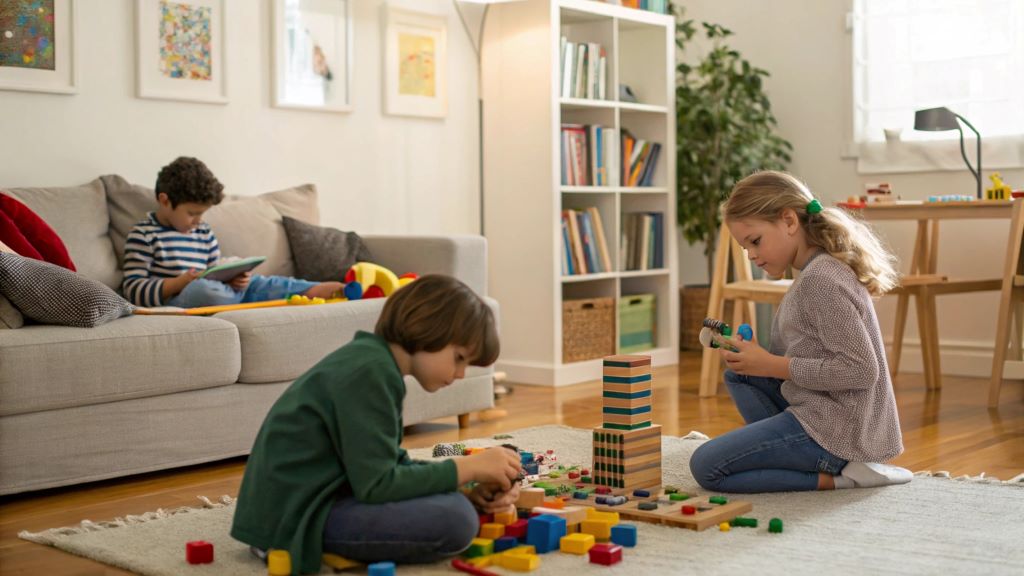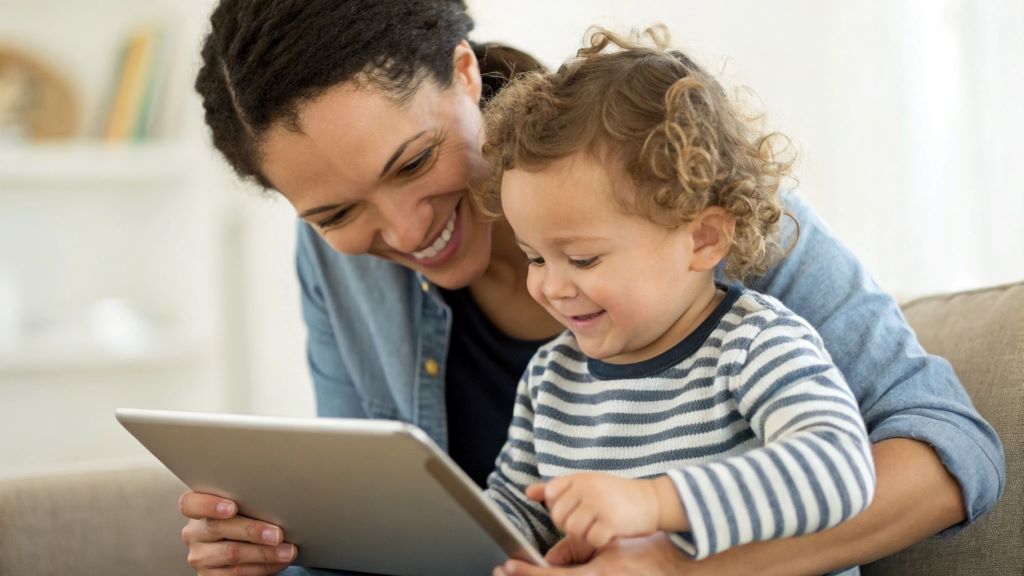The lullabies of today might include the soft glow of a smartphone screen, and the first “words” a baby hears could be from a video call with distant relatives. Technology has woven itself into the fabric of daily life so deeply that it’s nearly impossible to shield our babies from it entirely. As we navigate the digital age with our littlest ones , instead of an all-or-nothing approach, the focus must shift to conscious and responsible integration. The goal is to harness the benefits technology might offer while safeguarding against potential pitfalls that could impact a baby’s physical, cognitive, and emotional development. This guide aims to equip parents and caregivers with the knowledge and strategies to navigate the digital landscape safely and effectively, ensuring that technology serves as a tool for enrichment, not a source of concern.
Keystones of Safe Technology Use Around Babies
Understanding the core principles behind safe technology use is crucial for creating a supportive environment for your baby. These keystones serve as a framework for informed decision-making.
1. Prioritizing Human Interaction and Engagement
At the heart of a baby’s development lies direct human interaction. Face-to-face communication, eye contact, responsive smiles, and verbal exchanges are fundamental for language acquisition, emotional regulation, and social bonding. Technology, if used excessively or as a primary source of entertainment, can displace these vital interactions.
- Active Engagement Over Passive Consumption: When technology is present, ensure it doesn’t replace your active engagement with your baby. For instance, if you’re watching a video with your baby, talk about what you see, point things out, and gauge their reactions.
- Reading Aloud and Playtime: Dedicate ample time to traditional activities like reading physical books, playing with age-appropriate toys, and engaging in imaginative play. These activities foster creativity, fine motor skills, and direct interaction.
- The “Back-and-Forth” of Conversation: Even before a baby can speak, they are absorbing language and social cues. Engage in “serve and return” interactions, responding to their babbles and gestures, which forms the foundation of communication.
2. Understanding Screen Time Recommendations
Major health organizations, such as the American Academy of Pediatrics (AAP) and the World Health Organization (WHO), provide guidelines for screen time for young children. These recommendations are based on extensive research into child development.
- Under 18-24 Months: Avoid Screen Media (Except Video-Chatting): For infants younger than 18-24 months, the AAP recommends avoiding screen media, with the exception of video-chatting with family and friends. This is because babies at this age learn best from direct interaction with people.
- 18-24 Months to 5 Years: Limited and High-Quality Content: For children aged 18-24 months to 5 years, limited screen time (around one hour per day) of high-quality, educational content is recommended, always co-viewed with a parent or caregiver.
- Rationale for Limitations: Excessive screen time in infancy can be linked to potential delays in language development, reduced attention spans, sleep disturbances, and a decrease in physical activity.
3. Creating “No-Tech” Zones and Times

Establishing clear boundaries for technology use can help reinforce its proper place in the family dynamic.
- Mealtime and Bedtime: Designate mealtimes and bedtimes as technology-free zones. This promotes family bonding, encourages mindful eating, and supports healthy sleep routines.
- Play Areas: Keep play areas free from distracting screens. Encourage exploration and imaginative play without the constant temptation of digital devices.
- Outings and Walks: Use outings as opportunities for observation and interaction with the real world, rather than relying on devices for entertainment.
4. Mindful Parental Technology Use
Children are keen observers, and parental technology habits significantly influence a child’s perception and use of devices.
- Lead by Example: Model responsible technology use. If your baby constantly sees you glued to your phone, they are more likely to develop similar habits.
- Be Present: When you are with your baby, try to minimize distractions from your devices. Put your phone away, silence notifications, and give your full attention.
- Explain Your Use: As your child grows, you can briefly explain why you’re using a device (e.g., “I’m just checking the weather,” or “I’m sending a quick message to Grandma”). This helps them understand that technology has a purpose beyond constant entertainment.
5. Protecting Against Physical Hazards
Technology devices, while seemingly innocuous, can pose physical risks to curious infants.
- Choking Hazards: Small, removable parts from devices, chargers, and accessories can be choking hazards. Ensure all technology is kept out of reach.
- Cords and Cables: Cords and cables pose strangulation risks. Secure them out of your baby’s grasp and avoid leaving them dangling.
- Overheating Devices: Laptops, tablets, and phones can generate heat. Do not place them directly on or near your baby, especially while charging.
- Germs: Electronic devices can harbor germs. Regularly clean screens and surfaces of devices that your baby might touch.
- Blue Light Exposure: The blue light emitted from screens can disrupt sleep patterns and potentially impact eye development. Avoid screen use before bedtime.
6. Considering Content Quality and Co-Viewing
If and when screen time is introduced for older infants (closer to 24 months and beyond), the quality of content and parental involvement are paramount.
- Age-Appropriate and Educational Content: Choose content that is specifically designed for young children, is educational, and promotes positive messages. Avoid fast-paced, overstimulating, or violent content.
- Co-Viewing and Interaction: Always co-view content with your baby. Talk about what you’re seeing, ask questions, and relate it to real-world experiences. This transforms passive viewing into an interactive learning experience.
- Avoid Using Technology as a Pacifier: While tempting in moments of distress, relying on screens to calm a crying baby can hinder their ability to develop self-soothing mechanisms.
Potential Concerns and Long-Term Implications
While the immediate concerns are vital, it’s also important to be aware of the potential long-term implications of early and excessive technology exposure.
- Impact on Language Development: Research suggests that excessive screen time can be associated with delayed language development in young children. Babies learn language best through human interaction and the nuances of conversation.
- Attention Span and Cognitive Development: Rapidly changing images and sounds on screens can overstimulate a baby’s developing brain, potentially impacting their ability to focus and engage in sustained attention.
- Sleep Disturbances: The blue light emitted from screens can suppress melatonin production, a hormone essential for sleep, leading to difficulties in falling asleep and staying asleep.
- Physical Activity and Obesity: Time spent in front of a screen is time not spent in active play and exploration, which are crucial for physical development and maintaining a healthy weight.
- Eye Strain and Vision Issues: While more research is needed, concerns exist about the long-term effects of prolonged screen exposure on developing eyes, including eye strain and potential myopia.
- Social and Emotional Development: Excessive screen time can limit opportunities for face-to-face social interactions, which are critical for learning about emotions, empathy, and social cues.
- Addiction and Dependency: Introducing technology too early and without limits can potentially lead to unhealthy dependency on devices as children grow older.
Read More: Got a Silicone Breast Pump? Here’s How to Use It Effectively
FAQs: Addressing Common Questions about Technology and Babies
Q1: Is it okay to use a tablet to show my baby educational videos?
A1: For babies under 18-24 months, it’s generally recommended to avoid screen media (except for video-chatting with family). For older infants approaching 24 months, if you choose to introduce screen time, ensure it’s high-quality, educational content, and always co-view it with your baby, talking about what you see. Direct interaction is far more beneficial for their development at this age.
Q2: My baby loves looking at my phone when I’m on a video call. Is that harmful?
A2: Video-chatting with family and friends is often considered an exception to screen time recommendations for infants. It allows babies to interact with familiar faces and voices, which can be stimulating and positive. However, keep these interactions brief and ensure your baby isn’t simply staring passively at the screen.
Q3: How can I minimize my own technology use when I’m with my baby?
A3: Set boundaries for yourself. Designate “no-phone zones” like the nursery or during mealtimes. Turn off non-essential notifications. Put your phone away during play and feeding times. Remember that your baby learns by observing you, so modeling mindful technology use is key.
Q4: Are there any benefits to technology for babies?
A4: While direct screen time has limited benefits for infants, technology can offer indirect benefits to parents and caregivers. This includes accessing reliable information on child development, connecting with support networks, or using apps for tracking feeding or sleep schedules. For older infants (closer to 24 months), high-quality, interactive content can introduce concepts and vocabulary when co-viewed.
Q5: What are the signs that my baby might be getting too much screen time?
A5: While research is ongoing, some potential signs could include: difficulty focusing on other activities, increased irritability when screens are removed, sleep disturbances, delays in language milestones, or a preference for screens over interactive play. If you have concerns, consult with your pediatrician.
Q6: What about background TV or music from devices? Is that okay?
A6: Even background noise from TVs or devices can be distracting and reduce the quality of direct interaction with your baby. It can also make it harder for babies to process and learn language. It’s best to create a quiet environment for interaction and play. If you play music, opt for calming, instrumental tunes and keep the volume low.
Q7: How do I childproof my home for technology devices?
A7: Keep all devices, chargers, and small accessories out of reach of your baby. Secure all cords and cables to prevent strangulation hazards. Use outlet covers for unused plugs. Store devices in locked cabinets or drawers when not in use.
Q8: My baby seems fascinated by bright screens. Is that a sign they need more screen time?
A8: Babies are naturally attracted to bright, moving objects and sounds. This fascination doesn’t necessarily indicate a developmental need for screen time. Instead, it highlights their sensory sensitivity. Redirect their attention to age-appropriate toys, books, and direct interaction, which are more beneficial for their developing brains.
Conclusion: Nurturing Development in a Digital World
The safe use of technology around babies is not about complete abstinence, but rather about intentionality, balance, and prioritizing the foundational elements of healthy development. By understanding the recommendations, implementing thoughtful boundaries, and modeling responsible habits, parents and caregivers can create an environment where technology serves as a beneficial tool rather than a potential hindrance. The most valuable “screen time” for a baby remains the one-on-one interaction with loving caregivers – the smiles, the stories, the songs, and the shared moments that build strong bonds and lay the groundwork for a lifetime of learning and well-being. Fostering a child’s holistic development in the digital age requires a conscious effort to ensure that human connection and real-world exploration remain at the forefront.
Read More:
Baby’s First Winter? No Problem! The Cutest and Coziest Hats and Hoods for Baby
Wudola Baby Balance Bike: Empowering Toddlers on Their First Ride to Independence!




